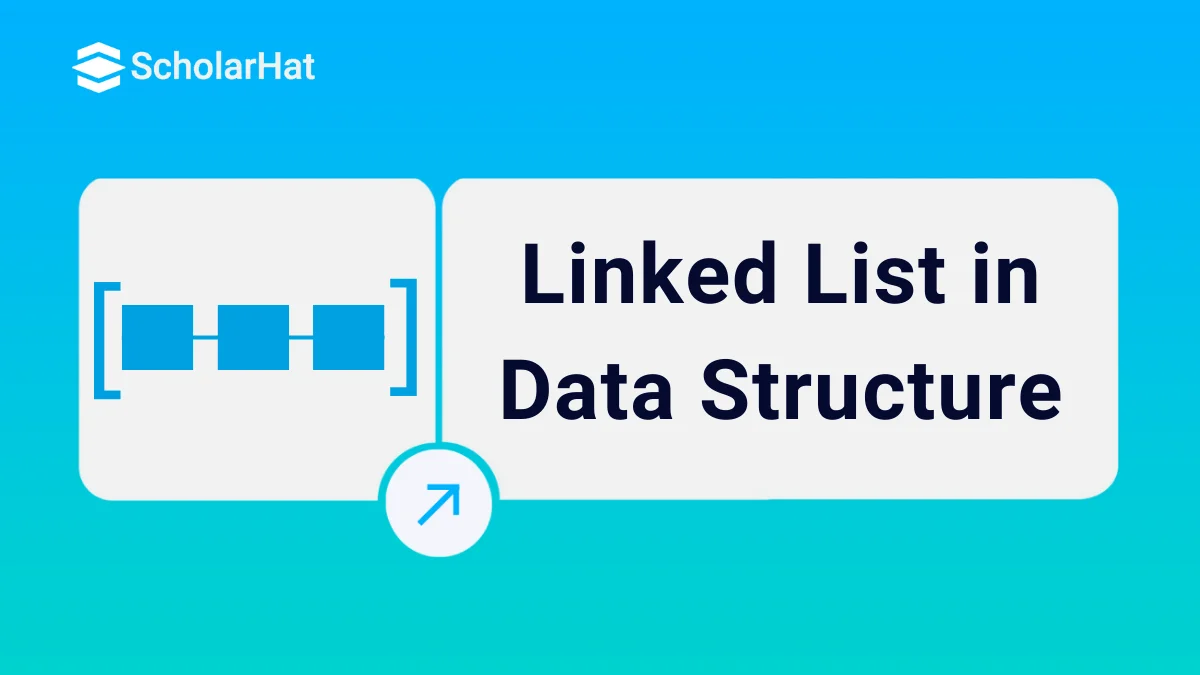12
DecLinked List in Data Structures - Types of Linked Lists & Its Applications
Linked List in data structures is a non-primitive, linear, and dynamic data structure. It is a chain of nodes where each node is a different element.
In this DSA tutorial, we will see the linked list data structure in detail i.e. its features, working, implementation, etc. DSA proficiency is valued by 90% of software engineering recruiters. Kickstart your career with our Free DSA Course with Certificate now!
What is a Linked List in Data Structures?

Linked List is a fundamental linear data structure used to store elements in a sequential manner. Unlike arrays, the elements (called nodes) in a linked list are not stored in contiguous memory locations. Instead, each node is dynamically allocated and connected using pointers.
Each node in a linked list consists of two parts:
- Data: The actual value or information stored.
- Pointer (or Reference): A link to the memory address of the next node in the sequence.
The first node of a linked list is known as the Head, and it serves as the entry point to the list. The last node is called the Tail, which points to NULL, indicating the end of the list.
Types of Linked Lists in Data Structures

- Singly-linked list: Here, each node has
dataand apointerthat contains a reference to the next node in the list. This means that we can traverse in only one direction, from theheadto thetail. It is the most common linked list. - Doubly linked list: In this type of linked list, each interconnected node contains three fields that contain references to both the next and previous nodes in the list along with the data. This allows traversal in both directions, making it easier to insert or delete nodes at any point in the list.
- Circular linked list: Here, the last node in the list contains a reference to the first node instead of
NULL, creating a loop. This means that traversal can continue indefinitely, until the program crashes.
How to declare/create a Singly-Linked List in Data Structures?
We now very well know that a node in a linked list contains two parts, adata item and the address of another node. So, both parts are of different types, i.e., one is a simple variable, while another is the pointer variable. We can declare the linked list by using the user-defined data type structure.struct node
{
int data;
struct node *next;
};
Here, we have created a structure named node that contains two variables, data of integer type, and a pointer, next that contains the address of the next node.
If you are still not thorough with pointers and user-defined data types like structures, refer to Data Types in C++ and Pointers in C++.
Standard Operations on Linked Lists in Data Structures
- Traversal
- This operation is used to visit each node of the linked list starting from the head node.
- By moving a temporary pointer from one node to the next, we can access and display the elements.
- The process stops when the pointer reaches NULL, indicating the end of the list.
- Insertion
Elements can be inserted at the beginning, middle, or end of the linked list. The process involves adjusting the next pointers carefully to maintain the list's integrity. The correct order of pointer manipulation is crucial to avoid losing the connection to the rest of the list. Inserting a new node at any given position is done by manipulating at most two next pointers, the prevNode and the newNode.
- Set
newNode'snext pointer to theprevNode'snext pointer and setprevNode'snext pointer to thenewNodewhereprevNodedenotes a pointer to the node after whichnewNodeis to be inserted. - However, to access any given position, we have to traverse starting from the
headtill theprevNode.
The order of execution matters in case of insertion. If we interchange the steps i.e. first set prevNode's next pointer to the newNode then we lose the reference to the remaining of the linked list previously occurring after the prevNode.
- Deletion
This operation removes a node from the list at a given position. Similar to insertion, it requires updating next pointers correctly to maintain connectivity. The correct order of operations ensures no loss of remaining nodes after deletion. Deleting a node located at a specified index is done by manipulating at most two next pointers, the prevNode, and the targetNode.
Set prevNode's next pointer to the targetNode's next pointer and set targetNode's next pointer to NULL where prevNode denotes a pointer to the node after which targetNode is to be deleted.
Just like insertion, the order is important here also. It's important to realize that setting targetNode's next pointer to NULL as the first step would cost us the reference to the remaining of the linked list (if the targetNode wasn't the Tail).
- Search
The search operation is used to find whether a given element exists in the list. Starting from the head, each node's value is compared with the target value until a match is found or the end of the list is reached. It is performed to search for an element from the list using the given key.
The following are the steps to search for an element
- Make
headas the current node. - Run a loop until the current node is
NULLbecause the last element points toNULL. - In each iteration, check if the
keyof the node is equal to the item. If thekeymatches the item, return true otherwise return false.
Read More - Data Structure Interview Questions for Freshers
Implementation of Linked Lists in Different Programming Languages
class Node:
def __init__(self, data=0, next_node=None):
self.data = data
self.next = next_node
class LinkedList:
def __init__(self):
self.head = None
def traversal(self):
itr = self.head
while itr:
print(itr.data)
itr = itr.next
def insertion(self, prev_node, new_node):
new_node.next = prev_node.next
prev_node.next = new_node
def deletion(self, prev_node, target_node):
prev_node.next = target_node.next
def search(self, key):
itr = self.head
while itr:
if itr.data == key:
return True
itr = itr.next
return False # key not found!
linked_list = LinkedList()
linked_list.head = Node(1)
second = Node(2)
third = Node(3)
linked_list.head.next = second
second.next = third
# Print the initial linked list
print("Initial Linked List:")
linked_list.traversal()
# Insert a new node (4) after the second node
new_node = Node(4)
linked_list.insertion(second, new_node)
# Print the linked list after insertion
print("\nLinked List after Insertion:")
linked_list.traversal()
# Delete the second node
linked_list.deletion(linked_list.head, second)
# Print the linked list after deletion
print("\nLinked List after Deletion:")
linked_list.traversal()
# Search for a key (3) in the linked list
key = 3
print(f"\nKey {key} is {'found' if linked_list.search(key) else 'not found'} in the linked list.")
class Node {
int data;
Node next;
Node() {
this.data = 0;
this.next = null;
}
Node(int x) {
this.data = x;
this.next = null;
}
Node(int x, Node next) {
this.data = x;
this.next = next;
}
}
class LinkedList {
Node head; // 'head' - pointer to the first node of the linked list
// Constructor for creating a linked list
LinkedList() {
this.head = null;
}
void traversal() {
Node itr = head;
while (itr != null) {
System.out.println(itr.data);
itr = itr.next;
}
}
// 'newNode' - pointer to the node to be inserted
// 'prevNode' - pointer to the node after which insertion occurs
void insertion(Node prevNode, Node newNode) {
newNode.next = prevNode.next;
prevNode.next = newNode;
}
// 'targetNode' - pointer to the node to be deleted
// 'prevNode' - pointer to the node after which deletion occurs
void deletion(Node prevNode, Node targetNode) {
prevNode.next = targetNode.next;
}
boolean search(int key) {
Node itr = head;
while (itr != null) {
if (itr.data == key)
return true;
itr = itr.next;
}
return false; // key not found!
}
public static void main(String[] args) {
LinkedList list = new LinkedList();
// Example usage:
list.head = new Node(1);
Node second = new Node(2);
Node third = new Node(3);
list.head.next = second;
second.next = third;
// Print the initial linked list
System.out.println("Initial Linked List:");
list.traversal();
// Insert a new node (4) after the second node
Node newNode = new Node(4);
list.insertion(second, newNode);
// Print the linked list after insertion
System.out.println("\nLinked List after Insertion:");
list.traversal();
// Delete the second node
list.deletion(list.head, second);
// Print the linked list after deletion
System.out.println("\nLinked List after Deletion:");
list.traversal();
// Search for a key (3) in the linked list
int key = 3;
System.out.println("\nKey " + key + " is " + (list.search(key) ? "found" : "not found") + " in the linked list.");
}
}
#include <iostream>
using namespace std;
struct Node {
int data;
Node* next;
Node() : data(0), next(nullptr) {}
Node(int x) : data(x), next(nullptr) {}
Node(int x, Node* next) : data(x), next(next) {}
};
class LinkedList {
public:
Node* head; // pointer to the first node of the linked list
// constructor for creating a linked list
LinkedList() : head(nullptr) {}
void traversal() {
Node* itr = head;
while (itr != nullptr) {
cout << itr->data << endl;
itr = itr->next;
}
}
// 'newNode' - pointer to the node to be inserted
// 'prevNode' - pointer to the node after which insertion occurs
void insertion(Node* prevNode, Node* newNode) {
newNode->next = prevNode->next;
prevNode->next = newNode;
}
// 'targetNode' - pointer to the node to be deleted
// 'prevNode' - pointer to the node after which deletion occurs
void deletion(Node* prevNode, Node* targetNode) {
prevNode->next = targetNode->next;
delete targetNode;
}
bool search(int key) {
Node* itr = head;
while (itr != nullptr) {
if (itr->data == key)
return true;
itr = itr->next;
}
return false; // key not found!
}
};
int main() {
LinkedList list;
list.head = new Node(1);
Node* second = new Node(2);
Node* third = new Node(3);
list.head->next = second;
second->next = third;
// Print the initial linked list
cout << "Initial Linked List:" << endl;
list.traversal();
// Insert a new node (4) after the second node
Node* newNode = new Node(4);
list.insertion(second, newNode);
// Print the linked list after insertion
cout << "\nLinked List after Insertion:" << endl;
list.traversal();
// Delete the second node
list.deletion(list.head, second);
// Print the linked list after deletion
cout << "\nLinked List after Deletion:" << endl;
list.traversal();
// Search for a key (3) in the linked list
int key = 3;
cout << "\nKey " << key << " is "
<< (list.search(key) ? "found" : "not found") << " in the linked list." << endl;
return 0;
}
Output
Initial Linked List:
1
2
3
Linked List after Insertion:
1
2
4
3
Linked List after Deletion:
1
4
3
Key 3 is found in the linked list. Complexity Analysis of Linked List Operations
- Time Complexity
Operations Best Case Average Case Worst case Traversal O(n)O(n)O(n)Insertion O(1)O(1)O(n)Deletion O(1)O(1)O(n)Search O(1)O(n)O(n) - Space Complexity: The space complexity of the linked list for all operations is
O(n).
Arrays vs Linked Lists in terms of Time Complexity
| Operations | Array | Linked List |
| Random Access |
|
|
| Insertion and Deletion at the beginning |
|
|
| Insertion and Deletion at the end |
|
|
| Insertion and Deletion from any random location |
|
|
Differences between Arrays and Linked Lists
| Array | Linked List |
| It is a collection of elements of a similar data type. | It is a group of objects called nodes, which consists of two fields: data and address to the next node |
| An array stores elements in a contiguous memory location. | Linked lists store elements randomly at any address in the memory. |
| In an array, memory size is fixed while declaration and cannot be altered at run time. | Linked lists utilize dynamic memory, i.e. memory size can be altered at run time. |
| Elements in an array are not dependent on each other. | Elements in a linked list are dependent on each other, as each node stores the address of its next node. |
| Operations like insertion, deletion, etc., take more time in an array. | Operations like insertion, deletion, etc., take less time than arrays. |
| Memory is allocated at compile time. | Memory is allocated at run time. |
| It is easier and faster to access the element in an array with the help of Indices. | Accessing an element in a linked list is time-consuming as we have to start traversing from the first element. |
| Memory utilization is ineffective in arrays. E.g. if the array size is 5 and contains only 3 elements, the rest of the space will be wasted. | In linked lists, memory utilization is effective, as it can be allocated or deallocated at the run time according to our requirements. |
| Arrays support multi-dimensional structures. | Linked lists are typically used for one-dimensional structures. |
| Arrays are commonly used in low-level programming and for implementing data structures. | Linked lists are often used for specific data management needs like task scheduling and memory allocation. |
After seeing the above comparisons in general and in terms of time complexity, we observe that a linked list is not superior to an array or vice-versa. These data structures complement each other and sometimes become superior to the other in certain use cases.
Applications of Linked Lists
Linked lists are widely used in computer science for solving various programming problems and for building other data structures. Their ability to handle dynamic memory and efficient insertion and deletion makes them suitable for many applications. Here are the key applications of linked lists:
1. Implementing Other Data Structures- Linked lists serve as the foundation for building several important data structures, such as:
- Stacks (LIFO structure)
- Queues (FIFO structure)
- Graphs (Adjacency List representation)
- Hash Tables (to handle collisions using separate chaining)
2. Dynamic Memory Allocation- Operating systems and memory managers use linked lists to track free and used memory blocks. A free list is maintained using a linked list to allocate and release memory dynamically at runtime.
3. Handling Large and Variable Data Sets- When the size of the data is unknown or changes frequently during program execution, linked lists are preferred over arrays because they don’t require predefined sizing and can grow or shrink efficiently.
4. Navigation Systems-Doubly linked lists are used in web browsers to manage page history, enabling back and forward navigation between web pages.
5. Scheduling and Task Management- Operating systems often use circular linked lists to manage process scheduling, where the scheduler cycles through tasks in a round-robin manner.
6. Undo/Redo Functionality- Applications like text editors and drawing tools use linked lists to implement undo and redo actions, maintaining a history of previous states.
7. Polynomial Arithmetic- In mathematical computations, linked lists can be used to represent and manipulate polynomials where each node holds a term with its coefficient and exponent.
Advantages of Linked Lists
- Efficient Insertion and Deletion: Unlike arrays, inserting or deleting elements in a linked list does not require shifting other elements. Only the pointers need to be updated, making operations like insertion and deletion faster and more efficient, especially for large datasets.
- Flexibility in Implementation: Linked lists are highly versatile and serve as the foundation for various advanced data structures such as stacks, queues, graphs, and hash tables (with chaining). This flexibility makes them essential in many algorithmic and system-level implementations.
- Memory Efficiency: Linked lists utilize memory more effectively by allocating space only as needed. Since nodes are created dynamically, there is no unused or wasted memory as in the case of static data structures like arrays.
- Ease of Implementation: Implementing a linked list is relatively straightforward. It requires defining a simple node structure and a few pointer-based operations, making it a great choice for beginners learning data structures and memory management.
- Dynamic Size Allocation: Linked lists offer dynamic memory allocation, meaning the list can grow or shrink at runtime without predefined size limits. This makes them ideal for applications where the amount of data changes frequently.
- Memory Consumption: The use of
pointersis more in linked lists hence, complex and requires more memory. - Traversal: Unlike arrays, linked lists do not allow direct access to individual nodes. Traversing a linked list requires iterating through all the nodes from the beginning of the list until the desired node is found. This can be inefficient and slow, especially for large linked lists. Traversing in reverse order is not possible in singly linked lists.
- No Random Access: Linked lists do not support random access, i.e., accessing a specific node directly without traversing the list. This can be a significant disadvantage for some applications that require fast access to individual elements.
- Cache Misses: Linked lists can suffer from cache misses, i.e., when the CPU needs to access data that is not in the cache. This can slow down the execution of programs that frequently access data from linked lists.
- Search: Linked lists are not efficient for searching large amounts of data, which can be better handled by other data structures such as trees or
hash tables.
Summary
So, here we saw every aspect of a linked list in data structures. You might have got at least some idea regarding linked lists and their applications. I know it's quite difficult to understand the whole topic in a single go. Therefore, refer to it again and again till you get thorough with the linked list in data structures. To test your knowledge of linked lists, enroll in our Free Data Structures Certification Training.
Full-Stack Java Developers earn up to ₹38 LPA in India’s thriving tech market. Launch your high-paying career with our Full Stack Java Developer course today!
FAQs
- Singly-linked list
- Doubly linked list
- Circular linked list
Take our Datastructures skill challenge to evaluate yourself!

In less than 5 minutes, with our skill challenge, you can identify your knowledge gaps and strengths in a given skill.












